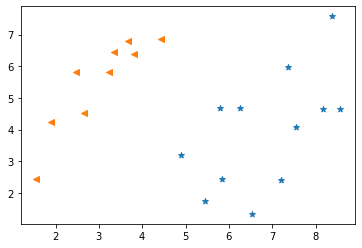Perceptron as a binary classifier#
1raise SystemExit("Stop right there!");
An exception has occurred, use %tb to see the full traceback.
SystemExit: Stop right there!
Importing libraries and packages#
1# System
2import os
3
4# Mathematical operations and data manipulation
5import pandas as pd
6
7# Modelling
8import tensorflow as tf
9
10# Statistics
11from sklearn.metrics import confusion_matrix
12from sklearn.metrics import accuracy_score
13
14# Plotting
15import matplotlib.pyplot as plt
16
17%matplotlib inline
1os.environ["TF_CPP_MIN_LOG_LEVEL"] = "2"
Set paths#
1# Path to datasets directory
2data_path = "./datasets"
3# Path to assets directory (for saving results to)
4assets_path = "./assets"
Loading dataset#
1dataset = pd.read_csv(f"{data_path}/data.csv")
1dataset.head()
| label | x1 | x2 | |
|---|---|---|---|
| 0 | 1 | 2.6487 | 4.5192 |
| 1 | 1 | 1.5438 | 2.4443 |
| 2 | 1 | 1.8990 | 4.2409 |
| 3 | 1 | 2.4711 | 5.8097 |
| 4 | 1 | 3.3590 | 6.4423 |
The data has three columns. x1 and x2 are the features, and the label column contains the labels 0 or 1.
Exploring dataset#
1plt.scatter(
2 dataset[dataset["label"] == 0]["x1"],
3 dataset[dataset["label"] == 0]["x2"],
4 marker="*",
5)
6plt.scatter(
7 dataset[dataset["label"] == 1]["x1"],
8 dataset[dataset["label"] == 1]["x2"],
9 marker="<",
10)
<matplotlib.collections.PathCollection at 0x7fe2e64dbdf0>

Training of the perceptron#
1# Split into features and labels. Convert values at the end into
2# matrix format
3x_input = dataset[["x1", "x2"]].values
4y_label = dataset[["label"]].values
1# Creating TensorFlow variables for features and labels and
2# typecasting them to float
3x = tf.Variable(x_input, dtype=tf.float32)
4y = tf.Variable(y_label, dtype=tf.float32)
1# Training of the perceptron
2Number_of_features = 2
3Number_of_units = 1
4learning_rate = 0.01
5
6# Weights and bias
7weight = tf.Variable(tf.zeros([Number_of_features, Number_of_units]))
8bias = tf.Variable(tf.zeros([Number_of_units]))
9
10# Optimizer
11optimizer = tf.optimizers.SGD(learning_rate)
1def perceptron(xx):
2 z = tf.add(tf.matmul(xx, weight), bias)
3 output = tf.sigmoid(z)
4 return output
5
6
7def train(i):
8 for n in range(i):
9 loss = lambda: abs(
10 tf.reduce_mean(
11 tf.nn.sigmoid_cross_entropy_with_logits(
12 labels=y, logits=perceptron(x)
13 )
14 )
15 )
16 optimizer.minimize(loss, [weight, bias])
17
18
19# Train the perceptron
20train(1000)
Statistics#
1tf.print(weight)
[[-0.844034076]
[0.673354685]]
1tf.print(bias)
[0.0593947768]
1# Passing the input data to check whether the perceptron
2# classifies it correctly
3ypred = perceptron(x)
4# Rounding off the output to convert it into binary format
5ypred = tf.round(ypred)
1# Measuring the accuracy
2acc = accuracy_score(y.numpy(), ypred.numpy())
3print(acc)
1.0
1# Performance measurement of the model
2cnf_matrix = confusion_matrix(y.numpy(), ypred.numpy())
3print(cnf_matrix)
[[12 0]
[ 0 9]]


